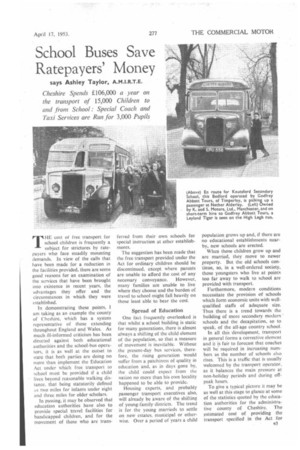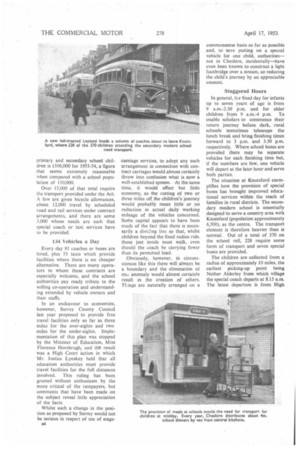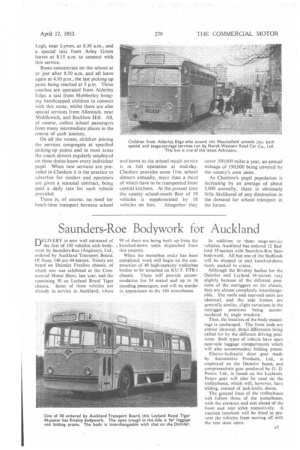School Buses Save Ratepayers' Money
Page 37

Page 38

Page 39

If you've noticed an error in this article please click here to report it so we can fix it.
says Ashley Taylor, A.M.I.R.T.E.
Cheshire Spends £106,000 a year on the transport of 15,000 Children to and from School : Special Coach and Taxi Services are Run for 3,000 Pupils THE cost of free transport for school children is frequently a subject for strictures by ratepayers who face steadily mounting demands. In view of the calls that have been made for a reduction in the facilities provided, there are some good reasons for an examination of the services that have been brought into existence in recent years, the advantages they offer and the circumstances in which they were established.
In demonstrating these points, I am taking as an example the county of Cheshire, which has a system representative of those extending throughout England and Wales. As much ill-informed criticism has been directed against both educational authorities and the school-bus operators, it is as well at the outset to state that both parties are doing no more than implement the Education Act under which free transport to school must be provided if a child lives beyond reasonable walking distance, that being statutorily defined as two miles for infants under eight and three miles for older scholars.
In passing, it may be observed that education authorities have also to provide special travel facilities for handicapped children, and for the movement of those who are trans
ferred from their own schools for special instruction at other establishments.
The suggestion has been made that the free transport provided under the Act for ordinary children should be discontinued, except where parents are unable to afford the cost of any necessary conveyance. However, many families are unable to live where they choose and the burden of travel to school might fall heavily on those least able to bear the cost.
Spread of Education One fact frequently overlooked is that whilst a school building is static for many generations, there is almost always a shifting of the child element of the population, so that a measure of movement is inevitable. Without the present-day bus services, therefore, the rising generation would suffer from a patchiness of quality in education and, as in days gone by, the child could expect from the nation no more than his own locality happened to be able to provide.
Housing experts, and probably passenger transport executives also, will already be aware of the shifting of young-family districts. The trend is for the young marrieds to settle on new estates, municipal or otherwise. Over a period of years a child population grows up and, if there are no educational establishments nearby, new schools are erected.
When those children grow up and are married, they move to newer property. But the old schools continue, so, in a well-ordered society, those youngsters who live at points too far away to walk to school are provided with transport.
Furthermore, modern conditions necessitate the provision of schools which form economic units with wellqualified staffs of adequate size. Thus there is a trend towards the building of more secondary modern' schools and the decapitation, so to speak, of the all-age country school.
In all this 'development, transport in general forms a corrective element and it is fair to forecast that coaches will be required in increasing numbers as the number of schools also rises. This is a traffic that is usually welcomed by the transport operator. as it balances the main pressure at non-holiday periods and during offpeak hours.
To give a typical picture it may be as well at this stage to glance at some of the statistics quoted by the education authorities for the administrative county of Cheshire. The estimated cost of providing the transport specified in the Act for primary and secondary school children is £106,000 for 1953-54, a figure that seems extremely reasonable when compared with a school population of 110,000.
Over 15,000 of that total require the transport provided under the Act. A few are given bicycle allowances, about 12,000 travel by scheduled road and rail services under contract arrangements, and there are some 3,000 whose needs are such that special coach or taxi services have to be provided.
134 Vehicles a Day Every day 81 coaches or buses are hired, phis 53 taxis which provide facilities where there is no cheaper alternative. There are many operators to whom these contracts are especially welcome, and the school authorities pay ready tribute to the willing co-operation and understanding extended by vehicle owners and their staffs.
In an endeavour to economize, however, Surrey County Council last year proposed to provide free travel facilities only so far as three miles for the over-eights and two miles for the under-eights. Implementation of this Plan was stopped by the Minister of Education, Miss Florence Horsbr ugh, and tht result was a High Court action in which Mr. Justice Lynskey held that all education authorities must provide travel facilities for the full distances involved. This ruling has been greeted without enthusiasm by the more critical of the ratepayers, but comments that have been made on the subject reveal little appreciation of the facts.
Whilst such a change in the position as proposed by Surrey would not be serious in respect of use of stage i34 carriage services, to adopt any such arrangement in connection with contract carriages would almost certainly throw into confusion what is now a well-established system. At the same time, it would effect but little economy, as the cutting of two or three miles off the children's journey would probably mean little or no reduction in actual daily working mileage of the vehicles concerned. Sothe capital appears to have been made of the fact that there is necessarily a dividing line so that, whilst children beyond the fixed radius ride. those just inside must walk, even should the coach be carrying fewer than its permitted load.
Obviously, however, in circumstances like this there will always be a boundary and the elimination of on anomaly would almost certainty result in the creation of others. Things are naturally arranged on a commonsense basis so far as possible and, to save putting on a special vehicle for one child, authorities— not in Cheshire, incidentally—have even been known to construct a light footbridge over a stream, so reducing the child's journey by an appreciable amount.
Staggered Hours In general, the fixed day for infants up to seven years of age is from 9 a.m.-3.30 p.m. and for older children from 9 a.m.-4 p.m. To enable scholars to commence their return journey before dark, _rural schools sometimes telescope the lunch break and bring finishing times forward to 3 p.m. and 3.30 p.m. respectively. Where school buses are provided there may be separate vehicles for each finishing time but, if the numbers are few, one vehicle will depart at the later hour and serve both parties.
The situation at Knutsford exemplifies how the provision of special buses has brought improved educational services within the reach of families in rural districts. The secondary modern school is essentially designed to serve a country area with Knutsford (population approximately 6,500), as the centre. The transport element is therefore heavier than is normal. Out of a total of 370 on the school roll, 228 require some form of transport and seven special buses are provided.
The children are collected from a radius of approximately 10 miles, the earliest picking-up point being Nether Alderley from which village the special coach departs at 8.15 a.m. The latest departure is from High Legh, near Lymm, at 8.30 a.m., and a special taxi from Arley Green leaves at 8.15 a.m. to connect with this service.
Buses concentrate on the school at or just after 8.50 a.m. and all leave again at 4.10 p.m., the last picking-up !vim. being reached at 5 p.m. Three coaches are operated from Alderley Edge, a taxi from Mobberley bringing handicapped children to connect with this route, whilst there are also special services from AlIostock, near Middlewich, and Bucklow Hill. All, of course, collect ichool passengers from many intermediate places in the course of each journey.
On all the routes, children joining the services congregate at specified picking-up points and in most areas the coach drivers regularly employed on these duties know every individua pupil. When new services are provided in Cheshire it is the practice to advertise for tenders and operators are given a seasonal contract; being paid a daily rate for each vehicle provided.
There is, of course, no need for lunch-time transport between school and home as the school-meals service is in full operation at mid-day. Cheshire provides some 11m. school dinners virtually, more than a third of which have to be transported from central kitchens. At the present time the county school-meals fleet of 19 vehicles is supplemented by 18 vehicles on hire. Altogether they cover 300,000 miles a year, an annual mileage of 190,000 being covered by the county's own units.
As Cheshire's pupil population is increasing by an average of about 3,000 annually, there is obviously little likelihood of any diminution in the demand for school transport in the future.




















































































